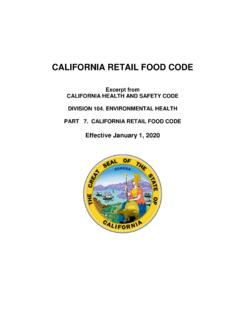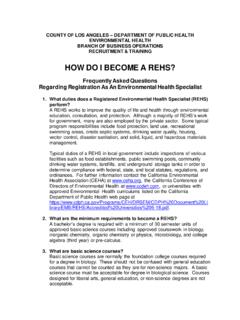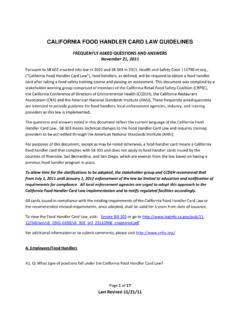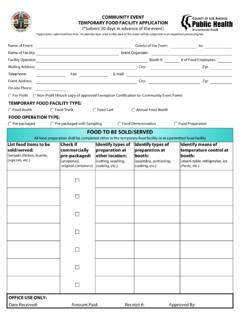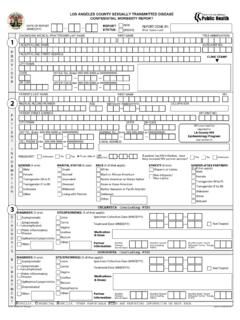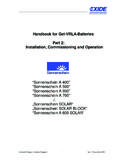Transcription of BACKFLOW PREVENTION ASSEMBLY TESTING MANUAL
1 BACKFLOW PREVENTION ASSEMBLYTESTING MANUALLos Angeles County Department of Public HealthEnvironmental ProtectionCross-Connection and Water Pollution Control ProgramTABLE OF CONTENTSTESTING TECHNIQUES .. 1-2 CONCEPTS OF BACKFLOW PREVENTIONASSEMBLY TESTING .. 3-4 SINGLE CHECK TYPE PRESSURE VACUUM BREAKERTUBE TEST PROCEDUREAir Inlet Opening Point .. 5-6 Check Valve Operation .. 7 TWO CHECK TYPE PRESSURE TYPE VACUUM BREAKERTUBE TEST PROCEDUREAir Inlet Operation .. 8-9 Check Valve Operation .. 10-11 DOUBLE CHECK VALVE ASSEMBLIESTUBE TEST PROCEDUREC heck Valve Operation .. 12-13 SINGLE CHECK PRESSURE TYPE VACUUM BREAKERGAUGE TEST PROCEDUREAir Inlet Operation .. 14-15 Check Valve Operation .. 16 SPILL-RESISTANT PRESSURE VACUUM BREAKERGAUGE TEST PROCEDUREAir Inlet Opening Point .. 17-18 Check Valve Closing Point .. 18 TWO CHECK PRESSURE TYPE VACUUM BREAKERGAUGE TEST PROCEDUREAir Inlet Operation .. 19 Check Valve Operation .. 20-21 DOUBLE CHECK VALVE BACKFLOW PREVENTION ASSEMBLYGAUGE TEST PROCEDUREC heck Valve #1 Operation.
2 22 Check Valve #2 Operation .. 23 REDUCED PRESSURE PRINCIPLE BACKFLOW PREVENTION ASSEMBLYGAUGE TEST PROCEDUREC heck Valve #1 Operation (apparent) .. 24 Relief Valve Operation .. 25#2 Check Valve Operation .. 25 Check Valve #1 Operation (static) .. 25 REDUCED PRESSURE PRINCIPLE DETECTOR BACKFLOW PREVENTION ASSEMBLYGAUGE TEST PROCEDURET esting Main Line ASSEMBLY .. 26 TESTING Bypass ASSEMBLY .. 26 DOUBLE CHECK DETECTOR BACKFLOW PREVENTION ASSEMBLYGAUGE TEST PROCEDURET esting Bypass ASSEMBLY .. 27 TESTING Main-Line ASSEMBLY .. 27 BACKFLOW PREVENTION ASSEMBLY TESTING ManualTesting Techniques1 TESTING TECHNIQUES REQUIRED FOR BACKFLOW CERTIFICATIONIN LOS ANGELES COUNTYGENERAL INFORMATIONB ackflow PREVENTION assemblies are to be tested according to the following instructions, and the resultsreported on test and maintenance forms furnished by the Health Department. Any part of the check valve,relief valve or air inlet valve found defective must be repaired or replaced immediately, and a retest mustshow the ASSEMBLY is operating properly.
3 Leaking shutoff valves which prevent a test from being mademust be PRESSURE GAUGE - dial range, 0-15 psi, psi intervals. The following is a list ofseveral gauges reviewed by the University of Southern California Foundation of Cross-Connection Controland Hydraulic Research and found to be acceptable as TESTING equipment for BACKFLOW PREVENTION devicesand meet general guidelines found in Section 9 of their 9th Edition of the MANUAL of Cross-ConnectionControl for TESTING Valves/Conbraco Industries, 40-200-TKU,Model 40-200-TK5 UAstraModel Promaster ASRP-4 Cameron(Formerly Prime Measurement, ITT Barton)Measurement Systems DivisionModel 226 Model 227 Model 246 Model 247 Model 226 CModel 227 CModel 246 CModel 247 CDanfoss Flomatic CorporationModel TK1 DukeModel 75 Model 75 BModel 100 Model 1000 Model EZ900 FebcoModel TK845-5 Meriam InstrumentModel 1124 Mid-WestModel 830 Model 835 Model 845-2 Model 845-3 Model 845-5 WattsModel TKDRM odel TKDPM odel TK99 DWilkins Regulator TG-3 Model TG-5 REDUCED PRESSURE PRINCIPLE BACKFLOW PREVENTERSR educed Pressure Principle BACKFLOW Preventers shall be tested by utilizing an acceptable differentialpressure CHECK VALVE ASSEMBLIESD ouble Check Valve assemblies shall be tested at one psi in the direction of flow by:a.
4 Utilizing a column of water no less than 27 " above the downstream reference point tube on theinlet side of each check valve with the downstream side at atmospheric pressure, or,b. Utilizing an approved differential pressure gauge with the high side of the gauge connected to theinlet side of each check valve, the gauge held at the top of the downstream reference point tubeand the downstream side of the check at atmospheric PREVENTION ASSEMBLY TESTING ManualTesting Techniques2 Approved type check valves used in BACKFLOW assemblies are required by design specifications to have amechanical closing load of at least one pound per square inch of area. This means that the check valve isheld shut by a spring or a weight until enough water pressure is built up in the normal direction of flow toovercome this mechanical load. The purpose is to have a check valve that will be tightly closed whenthere is no water can use this design fact to test check valves with the pressure developed by a short column of waterlocated before the check valves of single or double check valve pressure vacuum breakers and doublecheck valve TYPE VACUUM BREAKERSAir inlets of pressure type vacuum breakers shall be tested for opening loading of no less than psi by:a.
5 Utilizing a column of water no less than 27 " above the centerline of the air inlet valve seat andconnected between the preceding check valve and air inlet valve with the pressure below the airinlet valve relieved, or,b. Utilizing an approved differential pressure gauge with the high side connected between thepreceding check valve and the air inlet valve and the gauge held at the centerline of the air inletvalve seat with the pressure below the air inlet valve valves of pressure type vacuum breakers shall be tested at one psi in the direction of flow utilizingprocedures described under DOUBLE CHECK VALVE : While the use of water columns (tubes) for field test reporting purpose has beeneliminated, testers will still be required to demonstrate proficiency in tube TESTING of doublecheck valve assemblies and pressure type vacuum breakers at the time of certificationand recertification. Tube TESTING is a valuable technique for confirming differentialpressure gauge readings as well as checking gauge PRESSURE VACUUM BREAKERSS pill-resistant pressure vacuum breakers shall be tested by utilizing an acceptable differential PREVENTION ASSEMBLY TESTING ManualConcept3 CONCEPTS OF BACKFLOW PREVENTIONASSEMBLY TESTINGThe following outline is based upon the extensive cross-connection control program and lengthyoperational experience of the County of Los Angeles Department of Public are presumed to be familiar with BACKFLOW PREVENTION assemblies and various TESTING mention is made, therefore, of such procedures as blowing out test cocks, isolating units for test orconnecting test addition, particular reference is made to the differential pressure gauge since it has been found suitablefor all BACKFLOW PREVENTION ASSEMBLY TESTING .
6 Further, field TESTING of check valves in the direction of flow is the selected technique since it is inconformance with design specifications and laboratory field TESTING . It excels in ease of performance andis problem-free. TESTING in reverse of flow has, therefore, been Trouble-shooting is an integral part of TESTING and necessary to avoid unjustified assemblyreplacement or BACKFLOW PREVENTION assemblies must be tested under static (no flow) Compensating for No. 1 Shutoff Valve leaks on double check valve assemblies , pressurevacuum breakers and spill resistant vacuum breakers:!Gauge Connect the reference tube to the test cock downstream from the check valvebeing tested and fill with water. With the gauge connected to the test cock upstream ofthe check valve being tested, pressurize the gauge and close the number one shutoffvalve. Open the downstream test cock and make further adjustments to the bleed valveuntil there is a slight drip or meniscus on the reference tube.
7 Note and record the gaugereading.!Water Column Connect the reference tube to the test cock downstream from thecheck valve being tested and fill with water. Close test cock. Connect water column to theupstream test cock and fill with water to at least 27 " above the reference tube. Closetest cock. Close upstream shutoff valve. Open the downstream test cock. Open theupstream test cock. Wait till stabilized. Make adjustments to the bleed valve until there isa slight drip or meniscus on the reference tube. The check valve is holding tight if it holdsthe one pound water column. !Reference Tube - Connect the reference tube to the test cock downstream from thecheck valve being tested. Usually a small tube attached to a christmas tree/bleedapparatus to evaluate the integrity of the water shut off valves. The reference tube/bleedvalve combination allows for a meniscus of water to be established in the TESTING of checkvalves and shut off The differential pressure gauge, used as a low pressure gauge (high side only), in testingpressure vacuum breakers and double check valve assemblies can be applied to:a.
8 Detect leaks by reducing internal ASSEMBLY pressure below maximum:!Stable Gauge - No leaks!Rising Gauge - Indicative of inlet shut-off valve, leak. Compensate for leak through ableed valve, controlling flow to stabilize gauge. Exception: Leaking outlet shut-off valvewith back pressure; repair or replace valve.!Falling Gauge - Indicative of leaking fittings, connections or outlet shut-off valve leak. May or may not interfere with Determine pressure vacuum breaker air inlet opening values by reducing internal assemblypressure and observing gauge reading when inlet opens. Minimum acceptable reading: Determine check valve closing values in pressure type vacuum breakers and double checkvalve assemblies TESTING in the direction of flow by reducing the pressure downstream of anyBackflow PREVENTION ASSEMBLY TESTING ManualConcept4check valve to atmospheric and observing the upstream pressure at which the check valvecloses. Minimum acceptable value: : Accurate gauge readings of check valves are dependent on a soliddownstream reference point.
9 If the downstream test cock is at the highest pointon the valve body, this can be the reference point where the gauge is held. However, if the downstream test cock is below the top of the valve body, then apiece of pipe or tubing (Reference Tube) must be attached to the downstreamtest cock so that it rises at least to the top of the valve body. If a tube is attachedto the downstream test cock, then the gauge must be held at the same height asthe water in the reference When compensating for #1 shutoff valve leaks, make a final adjustment of the bleed valve tocreate a meniscus or slight drip from the downstream reference tube, with the downstreamtest cock open. The reading on the gauge should be greater than or equal to psi andrecorded as the static pressure across the A 27 " water column ( psi) can be used to establish whether minimum air inlet opening orcheck valve closing values is A water column can be used to verify gauge The second check of a reduced pressure principle ASSEMBLY can be tested as above; however, toavoid disturbing shut-off valve debris and possibly fouling the ASSEMBLY , TESTING in reverse ispreferable to TESTING in the direction of In TESTING a reduced pressure principle ASSEMBLY , a tester must recognize that a relief valvedischarge following closing of the downstream shut-off valve is caused by pressure equalizationacross a leaking first check valve.
10 Pressure spikes may be caused from closing downstreamresilient shutoff valves causing the second check disk to compress inducing the relief valve todischarge or if the second check was leaking, the pressure spike will make the relief In TESTING a reduced pressure principle ASSEMBLY , a tester must be able to distinguish between:a. A leaking downstream shut-off valve which prevents relief valve from opening and aninoperable relief valve: A zero gauge may be indicative of a defective relief valve sensing line. Flow through may be stopped using a by-pass from inlet to outlet test cocks or closing theinlet shut-off A relief valve continuous discharge caused by: a defective first check valve under a no flowcondition; a defective second check valve under back pressure; or, a defective relief valve. With gauge disconnected:!If closing the inlet shut-off valve causes the relief valve to fully dump, the first check valveleaks.!If closing the inlet shut-off valve produces no change in discharge, and opening testcocksin 4,3,2 order results in continuous flow at TC4 and TC3, the second check valve isleaking under back pressure; if flow occurs at TC2, either the first check valve leaks inreverse and/or the inlet shut-off valve leaks; if no flow occurs at TC4 and TC2, the reliefvalve is Achievement and maintenance of tester competency is a composite of initial instruction,certification followed by review of reporting and reinforcement, and reexamination/recertification atleast every two PREVENTION ASSEMBLY TESTING ManualPVB ####2" - Tube5 Figure 1 Tube and bleed valve connected for air inlet testSINGLE CHECK TYPE PRESSURE VACUUM BREAKERTUBE TEST PROCEDUREPVB Test Procedure - Part A: Air Inlet Opening PointMaterials required for test equipment:1.
